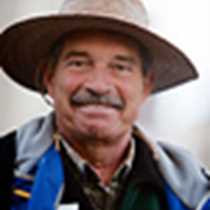Thomas Bay and Petersburg, Southeast Alaska
Thomas Bay is to be found on the mainland of Alaska, south of the state capital, Juneau. In the wee hours of the gray morning, we slowly approached within good distance of Baird Glacier. Here we saw that it is no more a tidal glacier, meaning it does not make contact with the ocean. A great amount of silty water runs off this ice mass, and taints the water brown. Around the corner and for only a brief time, we later visited Scenery Cove, a small, lovely water inlet partly shrouded in fog, surrounded by high mountains. After this visit, we headed off to another part of the bay, where a large river of ice water flows off the mountains, into the bay. Here we had our morning’s recreation in the form of hiking in different groups, nearer or farther along a series of lovely paths into the forest, as well as kayaking around small islets close inshore.
The first “awesome” thing of this hike was a cascade, giving the area the name of “Cascade Creek.” This water mass crashes down a series of huge boulders, becoming spray, which is taken in the direction of the path by the constant wind. The next segment of the path climbs a hill, quite steep, along a green understory formed by dwarf dogwood, salmonberry, two species of blueberries and different ferns. At this time of the year different mushrooms are to be seen. In the most boggy places the enormous-leaved skunk cabbages try to catch some sunlight.
During midday lunch we repositioned to Petersburg, a cozy fishing town on the island of Mitkof. Here some guests flew on helicopters and others on floatplanes to visit the Patterson Glacier. Meanwhile, we had interesting hikes in two different bogs, also called “muskegs” where, due to the acidity of the water in the soil, the two dominant trees of Southeast Alaska, the Sitka Spruce and the Western Hemlock, cannot survive. A series of other trees (among them mountain hemlock, Western redcedar, Alaska yellow cedar, lodge pole or shore pine and common juniper) can survive in this environment, but suffer from the terrible growing conditions and usually grow stunted, like small “bonsais.”
On another of the walks, where hikers reached a nearby river, they saw various fishermen and their catches: one had two king salmon, another one a coho salmon, and yet another one had caught a chum salmon.
Thomas Bay is to be found on the mainland of Alaska, south of the state capital, Juneau. In the wee hours of the gray morning, we slowly approached within good distance of Baird Glacier. Here we saw that it is no more a tidal glacier, meaning it does not make contact with the ocean. A great amount of silty water runs off this ice mass, and taints the water brown. Around the corner and for only a brief time, we later visited Scenery Cove, a small, lovely water inlet partly shrouded in fog, surrounded by high mountains. After this visit, we headed off to another part of the bay, where a large river of ice water flows off the mountains, into the bay. Here we had our morning’s recreation in the form of hiking in different groups, nearer or farther along a series of lovely paths into the forest, as well as kayaking around small islets close inshore.
The first “awesome” thing of this hike was a cascade, giving the area the name of “Cascade Creek.” This water mass crashes down a series of huge boulders, becoming spray, which is taken in the direction of the path by the constant wind. The next segment of the path climbs a hill, quite steep, along a green understory formed by dwarf dogwood, salmonberry, two species of blueberries and different ferns. At this time of the year different mushrooms are to be seen. In the most boggy places the enormous-leaved skunk cabbages try to catch some sunlight.
During midday lunch we repositioned to Petersburg, a cozy fishing town on the island of Mitkof. Here some guests flew on helicopters and others on floatplanes to visit the Patterson Glacier. Meanwhile, we had interesting hikes in two different bogs, also called “muskegs” where, due to the acidity of the water in the soil, the two dominant trees of Southeast Alaska, the Sitka Spruce and the Western Hemlock, cannot survive. A series of other trees (among them mountain hemlock, Western redcedar, Alaska yellow cedar, lodge pole or shore pine and common juniper) can survive in this environment, but suffer from the terrible growing conditions and usually grow stunted, like small “bonsais.”
On another of the walks, where hikers reached a nearby river, they saw various fishermen and their catches: one had two king salmon, another one a coho salmon, and yet another one had caught a chum salmon.




